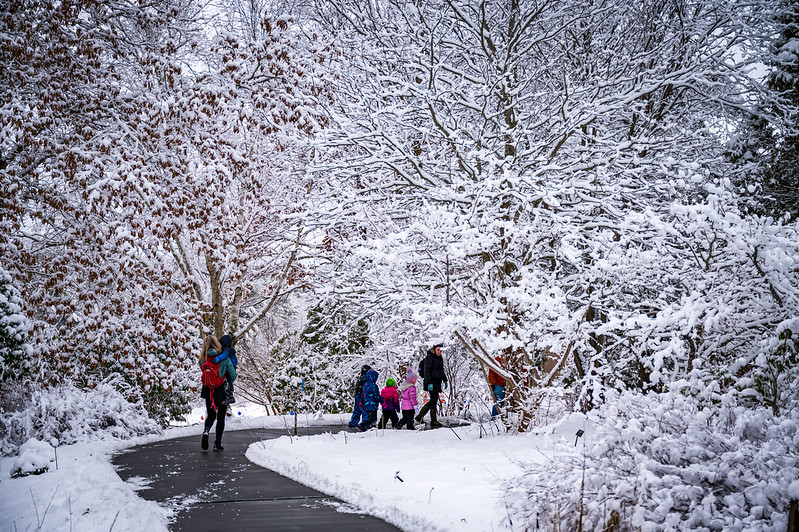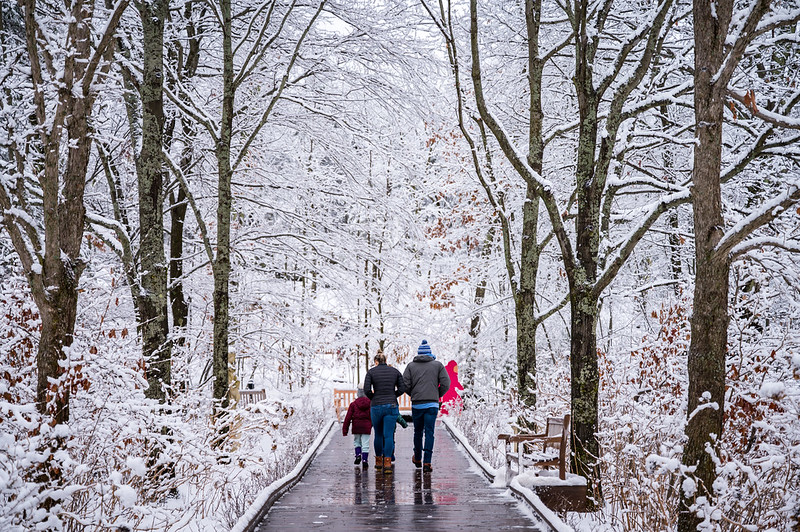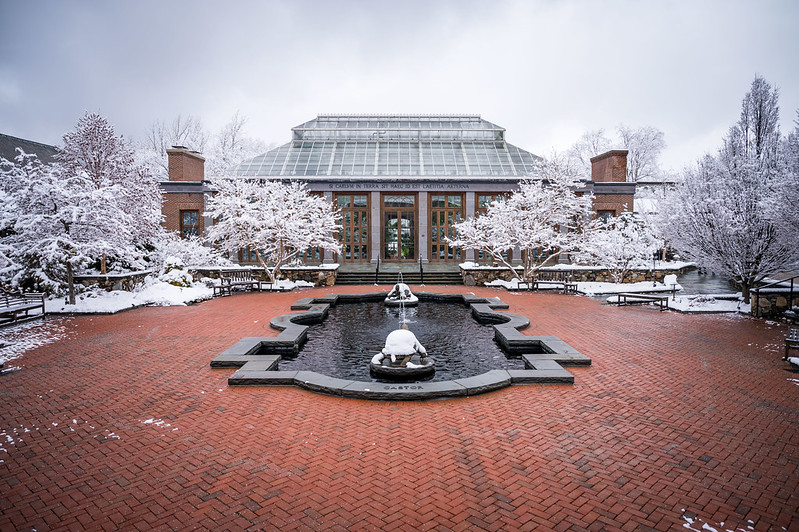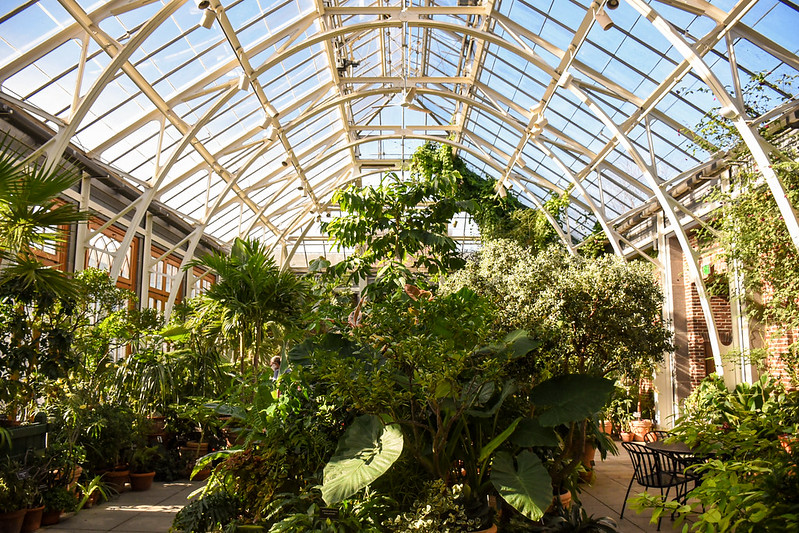EXPERIENCE WINTER AT THE GARDEN
This season at New England Botanic Garden, discover the quiet wonder of winter—animal tracks in the snow, the glimmer of ice on frozen branches, the soft chatter of birds foraging seeds and berries. Or warm up in subtropical conservatories filled with plants that will delight the senses. Enhance your visit with art, science, and wellness classes, family programming, exhibitions, and special events designed to not only nourish body, mind, and spirit, but also to inspire you in the growing season ahead. Plan your winter Garden visit today!
SCIENCE OF THE SEASON
Winter is a great time for wildlife watching at the Garden. While many birds migrate to warmer climates, others stick around. Look for black-capped chickadees and dark-eyed juncos foraging for seeds by the Wildlife Refuge Pond. Eastern bluebirds and cedar waxwings, insect-eaters in spring and summer, seek out berries on shrubs throughout the Garden, especially in the meadows. Near the forested edge of the Inner Park, look for raptors like hawks and owls. Small mammals scurrying between the cover of meadow grasses and the shade of shrubs are their prey. Pileated woodpeckers, turkeys, barred owls, screech owls, flying squirrels, foxes, racoons, fishers, and even bobcats have been seen (or heard!) on Garden grounds during winter as well.
Five trail cameras situated throughout our property document wildlife activity year-round. The footage we gather provides insights into the surrounding environment and the diverse habitats we seek to conserve. Check out a video of wildlife you could see signs of this winter. Be sure to look for animal tracks after a fresh fall of snow.
Almost every type of tree and shrub falls into one of two categories: deciduous or evergreen. As part of their growing cycle, deciduous trees move nutrients toward their roots as days shorten in autumn. They drop their leaves in the process and go dormant until spring when they have access to more resources. (Learn more about the science of autumn here.) An evergreen keeps its leaves or needles into the next growing season, holding on to them to collect energy from the sun year-round. In temperate regions with cold winters like New England, many people associate evergreens with conifers—pines, spruces, and firs to name a few—because these trees are common, even iconic, evergreens.
But not all coniferous plants are evergreen, and not all evergreens are coniferous. The term “coniferous” translates to “cone bearer.” Instead of a flower, coniferous trees and shrubs reproduce by creating cones that contain their seeds. A handful of deciduous cone-bearing trees exist around the world. The bald cypress (Taxodium distichum), whose native range stretches from the lower Atlantic Coastal Plant southwest along the Gulf of Mexico, and the dawn redwood (Metasequoia glyptostroboides), a tree endemic to China, both have needles that change color and drop in the fall.
Here in New England, broadleaved evergreen plants native to our landscape include great rosebay (Rhododendron maximum), holly (Ilex spp.), sweet bay magnolia (Magnolia virginiana), and more. These plants reproduce by flowering, making them some of our favorites year-round.
Research shows that winter is getting warmer. Cold snaps are shorter and average minimum temperatures are rising. In New England, the coldest season of the year is warming at a faster rate than other parts of the country, even other parts of the world. Between 1900 and 2020, burning fossil fuels caused the planet to warm an average of 1.14 degrees Celsius. In New England over that same time period, temperatures rose an average of 1.83 degrees Celsius. Massachusetts temperatures rose by even more—1.97 degrees Celsius—that’s 3.55 degrees Fahrenheit. While the difference between these numbers may seem small, the impacts are great, and they unfold in complex ways.
Waking Up Too Early
Multiple different environmental cues trigger the lifecycles of plants. New England’s native plants are more tolerant to the range of temperatures we experience, so they don’t wake from winter dormancy as readily during a warm spell. But plants grown in gardens outside of their natural range don’t sync as readily with the environment and often begin to wake from dormancy during unseasonably warm weather. If a plant emerges from dormancy too soon, it can lose buds when another cold snap hits, stymying its growth potential for the year.
Insect Threats
While our native plants may not yet be reacting to the higher-than-normal winter temperatures we’re experiencing, that doesn’t mean they’re out of the woods. Warm winters encourage the spread of insect pests. One of the most notable and damaging pests threatening our region is the hemlock wooly adelgid (Adelges tsugae), an introduced species of aphid-like insects that attack Carolina and Eastern Hemlocks, weakening and ultimately killing host plants. These insects were first documented in Massachusetts in 1988. Hemlock wooly adelgid is susceptible to cold winter temperatures, but it’s also extremely resilient. Warming winters support its survival and its spread north. The resultant rapid and widespread loss of hemlock trees across the eastern part of the U.S. in recent years has cascading impacts on other plants and animals that rely on hemlocks as a keystone species in the ecosystem. (Learn more here.)
Rain v. Snow
A few years ago, twelve inches of rain fell at the Garden in November, and we lost dozens of well-established plants in the collection like bearberry (Arctostaphylos uva-ursi) and other broad-leafed evergreens. Why did this occur? Saturated soils going into winter can lead to root rot. As winter gets warmer, more precipitation is expected to fall as rain instead of snow. Snowpack is important. While rain can inundate, snow provides water resources slowly as it melts into the spring season. And though it may seem counterintuitive, snow on the ground also provides important insulation to soil and plant roots. The role snow plays as ground cover during winter, how snow impacts soil chemistry, and the ecosystem-level effects of snowfall changes are subjects of ongoing research.
WINTER EXPERIENCES
Night Lights: Dazzling Gardens
November 22, 2025–January 4, 2026
Celebrate the magic of the winter season exploring illuminated gardens and festive activities for the whole family! Night Lights tickets are on sale now!
ELEVATED: An Orchid Exhibition
February 7 – March 22, 2026
Elevated: An Orchid Exhibition celebrates the beauty and wonder of orchids in combination with captivating aerial sculptures by artist Cicely Carew. Featuring a stunning display of more than 2,500 orchids, Elevated transforms the Garden’s subtropical conservatories into an immersive world of color, movement, and botanical brilliance
Fireside Concert
Friday, January 30 – Sunday, February 1
In partnership with Juventas New Music Ensemble, join us for an intimate concert experience set against the cozy backdrop of a crackling fire.
Disco Fever
Fridays & Saturdays, January 9 – 17
Get ready to boogie among the blooms. Bust a move under dazzling disco displays, dress in your best retro glam, and party like it’s the 1970s.
Illustrated: Art/Science at the Garden
Friday, January 23, 10 AM–4 PM | ONLINE
Saturday, January 24 | IN-PERSON at the Garden
Sunday, January 25 | IN-PERSON at the Garden
Illustrated: Art/Science at the Garden invites you to observe, imagine, and create through both microscope and paintbrush. Whether you’re an experienced illustrator or simply curious about plant anatomy and form, Illustrated offers a space to explore the creative and scientific side of the natural world.
Urban Tree Symposium
Friday, February 27, 2026, 9AM–4PM
Our annual Urban Tree Symposium is dedicated to exploring the importance of urban forests and ways we can improve our green spaces. Each symposium brings together experts in the fields of forestry, horticulture, biology, technology and more.
February Vacation: Fairytale Forest
Saturday, February 14 through Friday, February 20 | 10 AM–4 PM Daily
This February break, explore the enchanted woods where fairytale creatures roam. Each day is filled with imaginative games, creative crafts, and outdoor discoveries inspired by beloved storybooks.
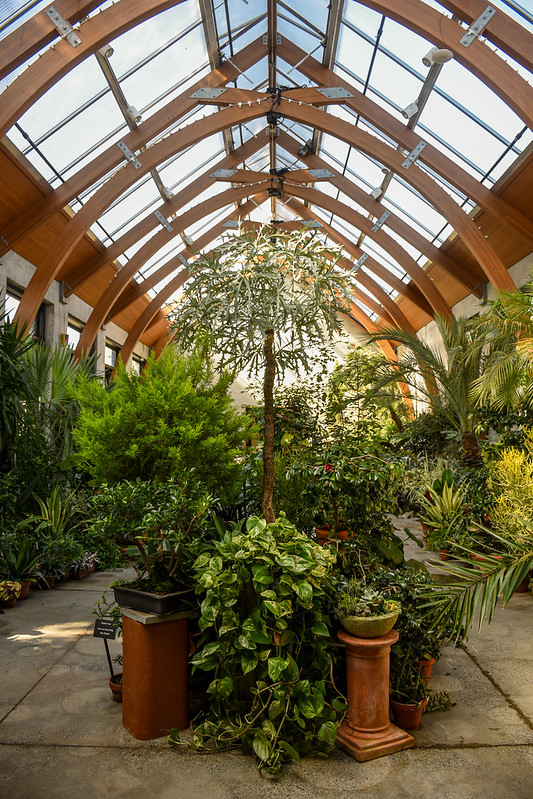
ESCAPE TO THE TROPICS
The Garden’s two conservatories feature a robust collection of subtropical plants that delight the senses with colorful, fragrant blooms. Mostly potted, the plants in these warm, bright garden spaces are arranged in ways that invite you to explore and relax. Visitors are encouraged to enjoy a lunch, read a book, or even bring some supplies to paint or sketch.
At around 55 to 65 degrees Fahrenheit, the Limonaia, or Lemon House, maintains a cooler seasonal temperature than its counterpart, the Orangerie. The Limonaia houses the Garden’s camellias (Camellia japonica), many of which are from the Isabella Stewart Gardener collection, as well as date palms, cycads, lemon trees, and other collection plants that prefer a slightly cooler, less humid atmosphere.
The Orangerie maintains balmy temperatures that make it the perfect home for our collection of citrus trees and shrubs. The glass conservatory is home to seven Versailles boxes, along with two vines—giant Dutchman’s pipe (Aristolochia gigantea) and Jade vine (Strongolodon macrobotrys)—and a number of plants planted directly into the floor of the building such as the lacy tree philodendron (Thaumatophyllum bipinnatifidum) and split-leaf philodendron (Monstera deliciosa variegata). In the earlier months of the year, visitors may catch the sweet scent of the Garden’s coconut orchid (Maxillaria tenuifolia) as they explore the plants of this conservatory.
WINTER PLANTS TO DISCOVER
Plants with “winter interest”—evergreen foliage, interesting bark patterns, colorful berries, or elegant forms—make gardens appealing during the cold-season months. At New England Botanic Garden, the aptly-named Winter Garden features a spectacular collection of winter stunners. Here are a few of our favorite plants to discover throughout formal and naturalistic gardens this winter:
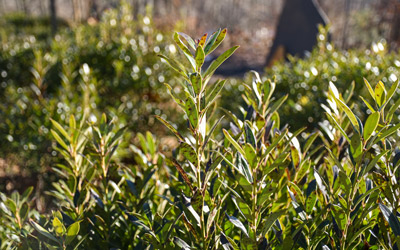
Inkberry holly (Ilex glabra)
This broadleaf evergreen shrub, commonly known as inkberry, is a native of Eastern North America. A member of the holly family, this plant boasts glossy, dark green leaves that remain an attractive feature in any garden during the winter months. Inkberry grows dark blue or black pea-sized berry-like drupes, or fruits, that birds flock to in the winter months. Find inkberry by the pavilion in The Ramble. You can also find a white-fruited selection in the Lawn Garden.
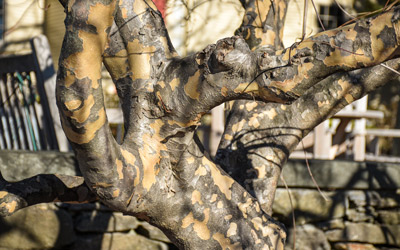
Kousa dogwood (Cornus kousa)
Creamy white “flowers” are highlights of a kousa dogwood in late spring, but these trees impress in all seasons. Fall color is stunning, from burgundy to orange, and foliage remains on the tree for weeks. Their bark exfoliates to expose beautiful patches of tan, gray, and brown, a source of winter interest when leaves have fallen. You can find multiple kousa dogwoods in the Lawn Garden.
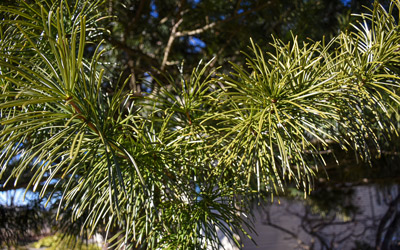
Japanese umbrella pine (Sciadopitys verticillata)
Also known as Japanese umbrella tree, this evergreen conifer is a slow grower native to Japan. It’s soft, flattened needles, deep but vibrantly green, radiate in a whorl reminiscent of an umbrella. It also features lovely pale brown, papery bark. This tree typically stretches to a height of 30 to 40 feet but can grow taller in its native range. Find an example in the Cottage Garden, next to the farmhouse.
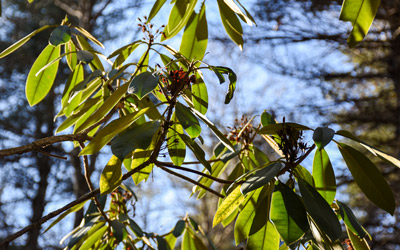
Great rosebay (Rhododendron maximum)
The Inner Park is home to a variety of native plants that offer winter interest, among them broadleaf evergreens like great rosebay or simply rhododendron. While in spring these woody shrubs boast beautiful pink and purple flowers, their leaves deepen to shades of dark green and even purple hues that offer color to contrast winter’s palette of grey. Trails through our Inner Park aren’t maintained, so come prepared for snow and ice.


